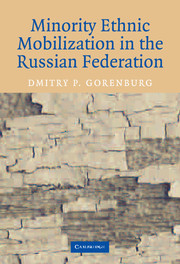Book contents
- Frontmatter
- Contents
- List of Figures and Tables
- Preface
- 1 Minority Ethnic Mobilization in Russia: An Introduction
- 2 Explaining Ethnic Mobilization: The Role of Ethnic Institutions
- 3 From Cultural Society to Popular Front: The Formation and Development of Nationalist Organizations
- 4 The Soviet Institutional Legacy and Ethno-Nationalist Ideology
- 5 Institutions Matter: Measuring Support for Nationalism
- 6 Intragroup Variation in Support for Nationalism: Not All Ethnics Are the Same
- 7 Outcomes: Did Regional Governments Adopt the Nationalist Agenda?
- 8 The Larger Picture: Support for Nationalism in Russia's Other Republics
- 9 Institutions and Nationalism
- Appendix: Construction of Variables and Indices
- References
- Index
1 - Minority Ethnic Mobilization in Russia: An Introduction
Published online by Cambridge University Press: 15 December 2009
- Frontmatter
- Contents
- List of Figures and Tables
- Preface
- 1 Minority Ethnic Mobilization in Russia: An Introduction
- 2 Explaining Ethnic Mobilization: The Role of Ethnic Institutions
- 3 From Cultural Society to Popular Front: The Formation and Development of Nationalist Organizations
- 4 The Soviet Institutional Legacy and Ethno-Nationalist Ideology
- 5 Institutions Matter: Measuring Support for Nationalism
- 6 Intragroup Variation in Support for Nationalism: Not All Ethnics Are the Same
- 7 Outcomes: Did Regional Governments Adopt the Nationalist Agenda?
- 8 The Larger Picture: Support for Nationalism in Russia's Other Republics
- 9 Institutions and Nationalism
- Appendix: Construction of Variables and Indices
- References
- Index
Summary
On 15 October 1991, the 449th anniversary of the conquest of Kazan by the Russian czar Ivan the Terrible, tens of thousands of Tatars gathered on Freedom Square, across from the Tatarstan Republic parliament. They were there to protest the government's refusal to issue a declaration of independence from the Russian Federation and the Soviet Union. The political situation in the republic had been tense for months, ever since a wave of nationalist demonstrations and hunger strikes in May had forced the government to disavow its support for allowing locals to vote in Russian presidential elections. Passions were further inflamed by the publication in the Tatar-language press of an article by the nationalist firebrand Fauzia Bairamova, which called for all real Tatars to show that they were not slaves to the Russians by demonstrating in the square. The October demonstration culminated in violence when protesters attempted to storm the parliament building and were rebuffed by police. Tensions were defused only when parliament agreed to adopt a declaration that confirmed the republic's sovereignty and to hold a referendum on the republic's independence.
Three months later and seemingly a world away, a few hundred Khakass nationalists gathered in front of the parliament in the newly created republic of Khakassia. They were protesting the election of an ethnic Russian as the chairman of the legislature as well as the legislature's reluctance to approve a sovereignty declaration. This was the first nationalist demonstration in Khakassia.
- Type
- Chapter
- Information
- Publisher: Cambridge University PressPrint publication year: 2003



